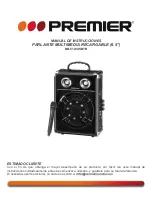
Dear HECO Customer,
Congratulations on your fine new loudspeakers and thank you very much for choosing HECO! You have
made an excellent choice. The high-quality speakers produced by HECO are renowned all over the world.
Please study the instructions and information below carefully before using your new loudspeakers.
GENERAL INFORMATION ABOUT CONNECTING YOUR HECO Celan GT LOUDSPEAKERS
Please always use a good quality loudspeaker connection cable from an audio dealer. To prevent
impairment of sound quality, we recommend cables with cross-sections of at least 2.5 mm² for lengths
up to 3 m and at least 4 mm² for lengths above 3 m.
Always turn off the amplifier or receiver before connecting or disconnecting loudspeaker cables. Place
the loudspeakers in their planned positions and cut the cables to the right length. The cables for both
channels should always be exactly the same length.
Strip 10 – 15 mm of insulation from the ends of the cables. Twist the ends – this is much better than tinning
them with solder – insert them in the terminals and tighten the terminal screws firmly (fig. 1). Loudspeaker
cables with CE-compliant banana or single-pin plugs (4 mm) or forked fittings can also be used.
For good sound it is imperative that the cables must be connected in such a way that the speakers are
“in phase”. This means that the black negative terminals on the speakers (-) must be connected to the
negative (-) terminals on the amplifier, the red positive (+) speaker terminals to the positive (+) amplifier
terminals. To make this easier one wire of most speaker cables is marked with a coloured strip or a ridge
in the insulation.
Before switching on the system double-check all your connections and make sure that the terminal screws
are tight and that there are no short circuits caused by stray wire filaments – this could cause serious
damage to your amplifier!
HECO CELAN GT - BI-WIRING AND BI-AMPING
Connector panel on the Heco Celan GT loudspeakers:
The connector panels on the Celan GT speakers are equipped with 5 terminal screws, enabling bi-
wiring/bi-amping in addition to conventional connection to an amplifier. The upper terminals are connected
to the treble and mid-treble side of the crossover and the lower terminals to the bass side. An additional
connector terminal enables a 2dB treble boost option.
Bi-wiring means using separate cables to carry the high and low audio frequencies. Bi-amping takes this
idea one step further and uses separate power amplifiers as well as separate cables for high and low
frequencies. Bi-amping in particular produces an additional improvement in sound reproduction quality.
For conventional connections, metal bridges are installed as standard to make the +2dB treble adjustment
active. The bridge can be switched to the linear setting by unscrewing the corresponding terminals. (Fig.2)
The terminals have to be removed for bi-wiring and bi-amping mode. Fig. 3 and fig. 4 show the connection
to the amplifier(s).
The right treble setting depends on the room, the positioning of the speakers and, of course, personal
taste. The +2dB setting is recommended for rooms with heavy upholstered furniture and curtains, for
example, which have a muffling effect.
THE HECO CELAN GT 302, 502, 702 AND 902 IN STEREO MODE
In the ideal configuration the speakers and the listening position should form an equilateral triangle. When
the left and right speakers are the same distance from the listening position their sound arrives at the same
time, resulting in a harmonious, natural music reproduction.
There should be a clear line of sight between the loudspeakers and the listening position. Any sound-
absorbing or reflecting obstacles in the path will distort the sound. When you install the loudspeakers the
following distances should be maintained:
GB
6







































